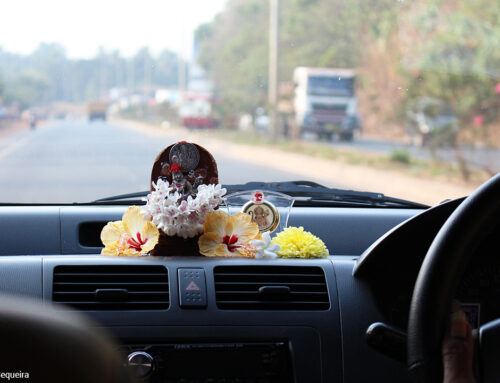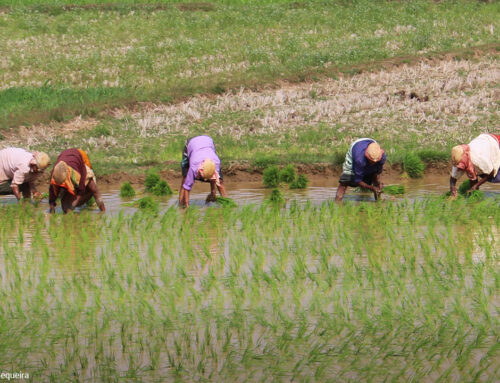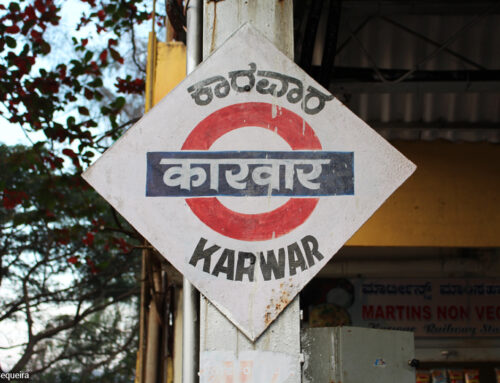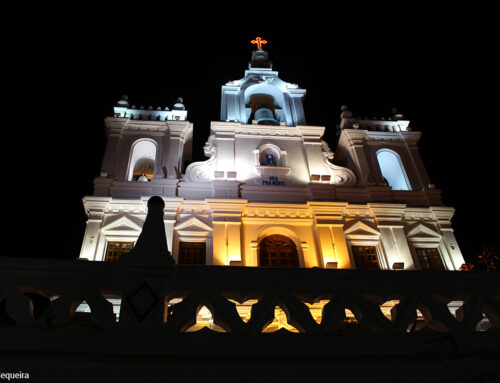Thank God for good old friends. Especially those who invite you to their home, and are genuinely happy to see you when you arrive there.
When Bernadine invited Alan and me to her family home in Malpe, all we knew was that the Furtado house was located in Thottam on the Malpe beach – regarded as the best location in South Kanara. So when the taxi brought us from Udupi station to their home, we were delighted to see that the house was not just beautiful – it offered a commanding and uninterrupted view of the Arabian Sea, and a glimpse of St. Mary’s Islands in the distance. Just a breeze away from Malpe beach, we had an ever-ending view of miles and miles of white sand, juxtaposed by the startling blue of the sea. Coconut palm trees stood like inebriated sentinels all around, swaying with the gentle sea breeze. Warm hospitality and cool sea breeze can be a heady combination, and soon we were overtaken by a drowsy numbness.
The next morning, Bernadine and her brother Terry indulged us with a typical Udupi breakfast which included ‘Sajjige Bajil’. A wonderful combination of Upma, mixed with spicy Poha (beaten rice) which I had never tasted before. This is the go-to breakfast dish for Udupi locals – easy to make, yet nutritious. We ate unhurriedly, sitting in the gazebo, listening to the cacophony created by nature’s musicians: crows, sparrows, parrots, dogs and cats. Punctuated by the occasional acapella voice of the wind. This was sheer bliss!
Time is measured by the meals you eat when you’re on vacation. On the Konkan coast, it is measured by the kind of seafood you eat. That day’s lunch was a just 2 minute walk from the Furtado home, in a outdoor shack on the beach called ‘Kulluga’. Literally meaning ‘Let’s sit down’ in the local language, Tulu. We contemplated the murals on one of the walls, which to our surprise featured Capt. Jack Sparrow from the movie Pirates of the Caribbean. We were served fresh Toddy that was harvested that very morning. We were at this shack for its celebrated seafood menu, but also because of the promise of Toddy, which was served in earthen pots. The taste of Toddy is unique – naturally sweet, with a hint of sour. I imagine its taste must come closest to Ambrosia. It’s always harvested at day-break and must be enjoyed soon after. All along the Konkan coast, the morning’s first human visitors are toddy-tappers, whose sure-footed climb up coconut trees helps bring down the fresh coconut sap which ultimately goes into making Toddy, the preferred drink of locals. I can still feel the taste of the Toddy on my tongue. Fresh, frothy and very refreshing. And then came the Crab Masala, which was spicy yet succulent. Messy yet delicious. Crispy fried local fish was devoured with equal gusto. Squid Sukka – dry preparation of squid – was mouth watering. And then, came the much sought-after local chicken delicacy – ‘Kori Rotti’ – Kori in Tulu means Chicken and Rotti is dry wafer-thin rice pancakes. Thick, creamy coconut-based chicken curry also called Kori Ghashi, is eaten with these Rottis, You gently crush the crispy Rotti and spoon the curry over. Wait a minute while the Rottis soak in the curry. Then simply slurp both in one swoop, enjoying every morsel – soggy and crispy all at once. Forget the spoon or fork. This is best enjoyed through the deft use of your fingers. We ate to our heart’s content, knowing that the much-needed siesta was just a few steps away. Check out for the Chicken Curry recipe in our Recipe Section.
Siestas can be very invigorating; especially if you can keep them short and sweet. And the post-siesta tea is extra special. After tea, we were ready and excited to visit the ‘Budvarchi Santh’ – the Wednesday local market in Udupi town. A smaller version of the Mapusa Friday Market in Goa, the concept remains the same: To put food from farm to table; the way it used to be before ‘genetically modified’ became curse words. Vegetables of all kind – including a variety of squashes, fish, meat, fruits, home-made sweets, coconuts, flowers, baskets, pots, and more jostled for attention. And deservedly so. Almost everything on sale was fresh, organic and hand-crafted by the people who sat there for hours, selling stuff they had put their heart and soul to grow or create. Alan, on a nostalgic high since we entered his home state of Karnataka, promptly bought the local jaggery. The fragrances and smells both invigorated and assailed our nostrils. But what a pleasure it is to bargain in Konkani, and share a laugh with folks who share your heritage.
The next day was reserved for a special outing. A half hour boat ride that began at Malpe Beach took us towards St Mary’s Islands, merely 4 miles away as the crow flies. It is said that in 1498, Vasco da Gama landed at St Mary’s Islands on his journey from Portugal to India. He fixed a cross on the island and named one of these islands O Padrão de Santa Maria as a dedication to the Virgin Mary, before proceeding to the Malabar Coast. It is from this name that the islands got their current name. This tropical island in the Arabian Sea is also a geological treasure, edged by a white, sandy beach, and dotted with rock monoliths, spectacular wildlife and migratory birds. The cluster includes four individual islands: Coconut Island, North Island, South Island and Daryabahadurgarh Island. From the ferry, the islands looked like a group of man-made stone pillars. A closer look introduces you to wondrous basaltic columns formed from igneous rocks. Basaltic lava naturally forms deep cracks, which eventually end up forming polygonal columns unique to these islands. While some have succumbed to the fury of the Arabian Sea tides, most still stand tall and upright, inviting the gaze of surprised tourists and ardent geologists. Watching the sun set amidst these rocks is one of the most alluring experiences on the island. A lone shack on the island sells cool drinks and snacks.
On our walk back from the ferry, we witnessed a pre-wedding shoot of a bridal couple. Gone are the days when the bride and groom saw each other on the day of the wedding. Here were the groom and bride, dressed to the nines, prancing to the orders of the drone-operating photographer. We watched their romantic antics for a while, shaking our heads over the western and technological influence on today’s India.
Thereafter, we made a customary visit to Stella Maris Church. Initially this church was a chapel and was later renovated to resemble a boat, funded by donations from the local folks working in the Arabian Gulf. Quite the anomaly on dry land. However, this church attracts many tourists who come visit for the unique experience of praying in nautical comfort.
Our sun-packed visit to Malpe was coming to an end. But I had one more thing to check off my to-do list: A visit to Manipal university, where Alan had completed his high school and pre-university education. Also, my niece Nicole, was doing her final year in Hospitality Management there. It was fortunate that Bernadine’s brother-in-law Leslie, the head of fire and safety at Manipal University. He graciously drove us around the entire university campuses. I was astounded at the size and spread of this university town. Alan was shocked by the changes in Manipal since his time here. There were colleges dedicated to every faculty, with hospitals, hotels and student hostels forming a formidable infrastructure. Dr. T.M.A. Pai and his family have created a totally self-sufficient and efficient university town on Manipal hill, that has been the pride of India for years. And for good reason. Eminent doctors and engineers have come out of its portals, including Satya Nadella, the CEO of Microsoft!
Driving through the campus at dusk, I was truly astounded by the vision of grand old Dr. Pai who bought a little hill and created a massive and iconic university town in Udupi. As the lights slowly came on and twinkled everywhere, I looked back for one final view of Manipal university, marvelling at the vision of one man, who’d changed so many lives.
The next day, was reserved for the temple town trail, and to sample Udupi’s famous vegetarian Thali. Let’s keep that for next time – Udupi Part 2. Stay tuned.
For photographs go to the Photo Gallery tab above; likewise for recipes.
Things to do in Malpe:
Beaches:
• Malpe
• Paradise
• St. Mary’s Islands (The regular ferry service plies every 20 minutes from the Malpe fishing harbour, except during the monsoons)
• Malpe Seawalk
Watersports:
• Kola Centre for a variety of water sports
Churches:
• Stella Maris
Temples:
• Vadabhandeshwara Balaram
Best time to visit: November – March
Know your Konkan Coast

The Konkan coast runs south from Mumbai all the way to Kasargod. Quaint fishing villages and magnificent forts look out into the endless blue of the Arabian sea. Pristine beaches and coconut palm trees dot the coast all along, until you reach Malvan, the last beach town of significance, before the sands dissolve into Goa. The cuisine along the Konkan coast is as varied as it is delicious, greatly influenced by its geographic location, and layered history of the region. They are all intertwined yet distinct. Some patterns are common – like the seasons which influenced bottling pickles, and drying of fish and pork etc. The monsoon brought a lot of seasonal foods like bamboo, snails (conge) etc to the table. Coconut is an integral part of the Konkan cuisine. Apart from local influences, Portuguese and Arab influences had major impacts.









“THE WORLD IS A BOOK AND THOSE WHO DO NOT TRAVEL READ ONLY A PAGE.” – a borrowed quote
Beautiful and evocative yet with simple descriptions. It betrays, if betrays is the word, Your copywriter’s experience, yet if you asked, I would say more travel-writing than copy.
After this pandemic is over, take a break, visit where your heart wants to go and let us know about it in good time.
By the way in my experience, Malvani cuisine outdoes the Goan and Udipi with respectful deference to both.
Thanks Roland. I’m glad I have yet another outlet for my writing skills. Alan’s beautiful photography adds to the beauty of this blog.
When I originally commented I clicked the -Inform me when new comments are included- checkbox and also now each time a remark is included I obtain four e-mails with the same remark. Is there any way you can remove me from that service? Many thanks! Marline Vinnie Naylor
Wow, incredible blog layout! How long have you been blogging for? Jacquie Baryram Severin
Thank you, Jacquie. We’ve been blogging since last Fall.
If some one wishes expert view about running a blog afterward i suggest him/her to visit this webpage, Keep up the pleasant job. Rita Carlin Julius Dalila Chaunce Leoline